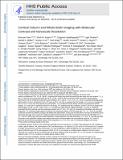| dc.contributor.author | Gao, Ruixuan | |
| dc.contributor.author | Asano, Shoh M | |
| dc.contributor.author | Huynh, Grace H. | |
| dc.contributor.author | Zhao, Yongxin | |
| dc.contributor.author | Boyden, Edward | |
| dc.date.accessioned | 2022-09-30T16:56:39Z | |
| dc.date.available | 2021-10-27T20:04:29Z | |
| dc.date.available | 2022-09-30T16:56:39Z | |
| dc.date.issued | 2019 | |
| dc.identifier.uri | https://hdl.handle.net/1721.1/134333.2 | |
| dc.description.abstract | © 2019 American Association for the Advancement of Science. All Rights Reserved. Optical and electron microscopy have made tremendous inroads toward understanding the complexity of the brain. However, optical microscopy offers insufficient resolution to reveal subcellular details, and electron microscopy lacks the throughput and molecular contrast to visualize specific molecular constituents over millimeter-scale or larger dimensions. We combined expansion microscopy and lattice light-sheet microscopy to image the nanoscale spatial relationships between proteins across the thickness of the mouse cortex or the entire Drosophila brain. These included synaptic proteins at dendritic spines, myelination along axons, and presynaptic densities at dopaminergic neurons in every fly brain region. The technology should enable statistically rich, large-scale studies of neural development, sexual dimorphism, degree of stereotypy, and structural correlations to behavior or neural activity, all with molecular contrast. | en_US |
| dc.language.iso | en | |
| dc.publisher | American Association for the Advancement of Science (AAAS) | en_US |
| dc.relation.isversionof | 10.1126/SCIENCE.AAU8302 | en_US |
| dc.rights | Creative Commons Attribution-Noncommercial-Share Alike | en_US |
| dc.rights.uri | http://creativecommons.org/licenses/by-nc-sa/4.0/ | en_US |
| dc.source | PMC | en_US |
| dc.title | Cortical column and whole-brain imaging with molecular contrast and nanoscale resolution | en_US |
| dc.type | Article | en_US |
| dc.contributor.department | Massachusetts Institute of Technology. Media Laboratory | en_US |
| dc.contributor.department | McGovern Institute for Brain Research at MIT | en_US |
| dc.contributor.department | Massachusetts Institute of Technology. Department of Biological Engineering | en_US |
| dc.contributor.department | Massachusetts Institute of Technology. Center for Neurobiological Engineering | en_US |
| dc.contributor.department | Massachusetts Institute of Technology. Department of Brain and Cognitive Sciences | en_US |
| dc.contributor.department | Koch Institute for Integrative Cancer Research at MIT | en_US |
| dc.relation.journal | Science | en_US |
| dc.eprint.version | Author's final manuscript | en_US |
| dc.type.uri | http://purl.org/eprint/type/JournalArticle | en_US |
| eprint.status | http://purl.org/eprint/status/PeerReviewed | en_US |
| dc.date.updated | 2019-07-19T16:02:21Z | |
| dspace.orderedauthors | Gao, R; Asano, SM; Upadhyayula, S; Pisarev, I; Milkie, DE; Liu, T-L; Singh, V; Graves, A; Huynh, GH; Zhao, Y; Bogovic, J; Colonell, J; Ott, CM; Zugates, C; Tappan, S; Rodriguez, A; Mosaliganti, KR; Sheu, S-H; Pasolli, HA; Pang, S; Xu, CS; Megason, SG; Hess, H; Lippincott-Schwartz, J; Hantman, A; Rubin, GM; Kirchhausen, T; Saalfeld, S; Aso, Y; Boyden, ES; Betzig, E | en_US |
| dspace.date.submission | 2019-07-19T16:02:24Z | |
| mit.journal.volume | 363 | en_US |
| mit.journal.issue | 6424 | en_US |
| mit.metadata.status | Publication Information Needed | en_US |
